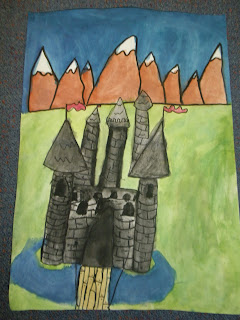 |
| By Denzelle, Year 3 student |
1) I showed students a black and white photograph (sourced from Google Images) of each of the 3 main characters from the Harry Potter movies.
2) We talked about symmetry and how faces are symmetrical.
3) I folded the 3 photos in half and we observed how the symmetry worked.
4) I demonstrated how to use charcoal to draw in half of a missing face, by copying the symmetrical features and using my fingers to help create accurate distances and widths in the facial features.
5) During this demonstration I explained how to get thin lines by using the sharp edges of the charcoal and how to lightly colour areas and smudge them with fingers to achieve shades of grey. We also talked about how including little features like eyelashes, eyebrows, eyelids, eye bags, smile lines, shadows etc, help to make the drawings look more realistic.
6) I then gave each of the students half of a photocopied photograph of one of the Harry Potter characters and students went back to their desks to draw in the missing half of the photographs using charcoal sticks (I like to use the thick synthetic compressed charcoal sticks with this age group- they don't break as easily and are nice and dark).
7) When the drawings were completed, we sprayed them with cheap hairspray to fix the charcoal and stop too many smudges!
Year 3 Drawings:
 |
| By Charlotte |
 |
| By Kaya |
 |
| By Aimee |
 |
| By Kaya |
 |
| By Andrew |
 |
| By Olivia |
 |
| By Tim |
 |
| By Tom |






















